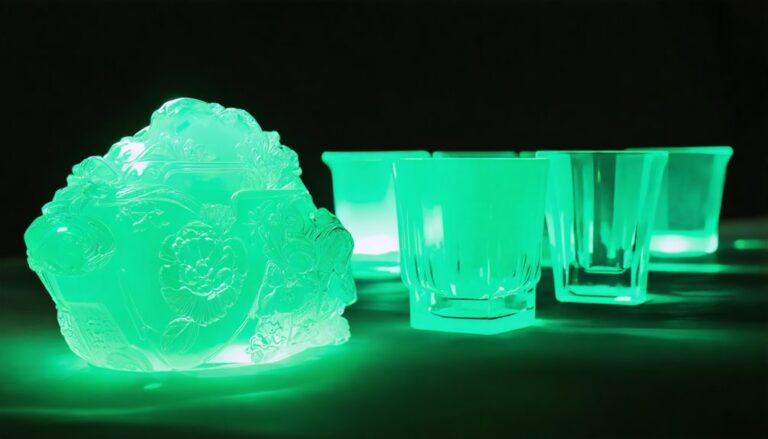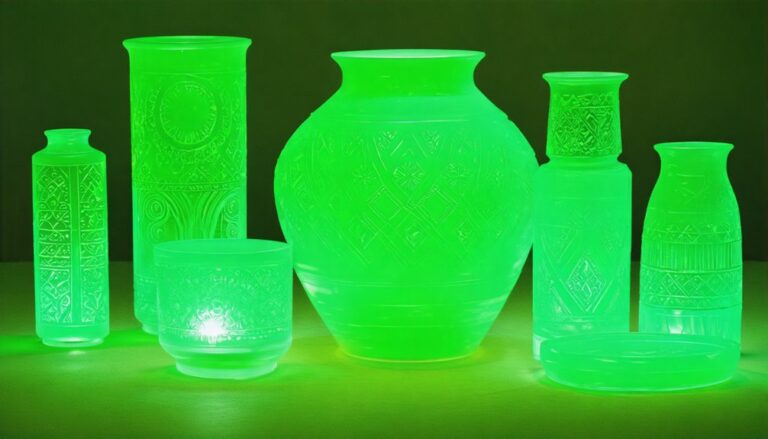Uranium Glass in Victorian England
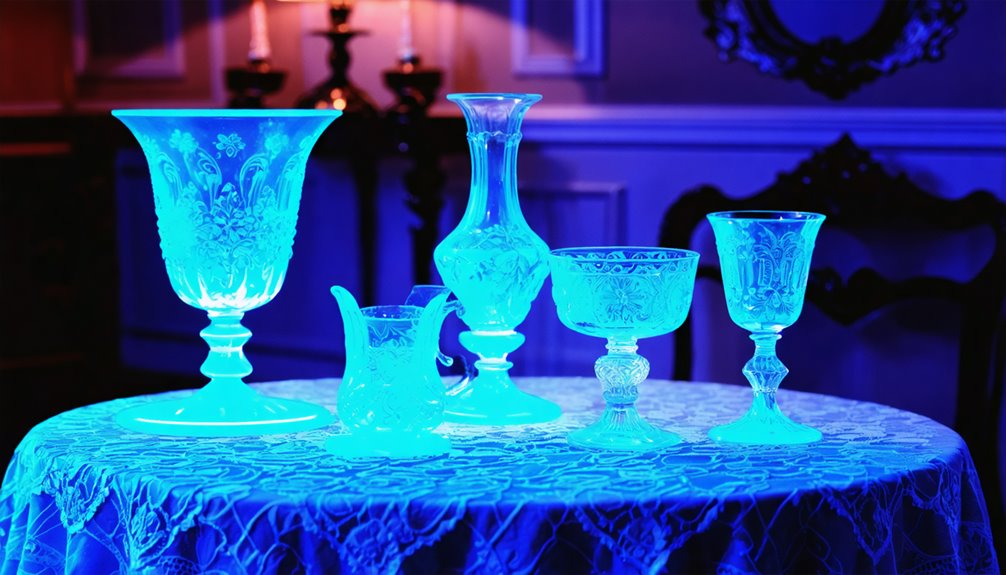
Uranium glass from Victorian England is not just a unique glowing green material. It tells a story about the tastes and interests of that time. The glass was made by adding uranium dioxide to molten glass, which created a beautiful and eye-catching product. People loved to decorate their homes with it. The glass often featured detailed floral designs and bold geometric shapes.
In the early days, uranium glass was seen as a novelty. People were fascinated by its glow under UV light. This made it a popular choice for tableware, vases, and decorative items. It was common to find it in middle and upper-class homes, where it sparked conversations among guests.
However, over time, concerns about safety emerged. The use of uranium in glass raised questions about health risks. As awareness grew, the popularity of uranium glass declined. Despite this, it remains a fascinating piece of history, reflecting an era filled with innovation and curiosity. There are still many aspects of this unique glass to explore.
Key Takeaways
Uranium glass first gained popularity in Victorian England during the 1880s. It is known for its striking yellow-green glow when exposed to ultraviolet light. This unique luminescence captured the interest of glassmakers and the public alike.
Victorians were fascinated by science and innovation. They loved to incorporate these elements into their art and design. Uranium glass became a trendy choice for tableware and decorative pieces. People admired its beauty and the way it shimmered in the light.
The introduction of gas lighting in homes made uranium glass even more appealing. The glow intensified, making these items a sought-after status symbol for the wealthy. Displaying uranium glass in a home showed off one’s taste and wealth.
At the time, there was limited understanding of the potential health risks associated with uranium. Many Victorians mistakenly believed that uranium glass had health benefits. Some thought it could purify water or provide other cleansing properties.
As time went on, awareness of safety concerns grew. Regulations about radioactive materials led to a decline in the popularity of uranium glass. However, interest was revived in the 1980s when collectors began to appreciate its charm and historical significance. Today, uranium glass is celebrated as a unique piece of Victorian history.
Discovery and Early Production
Many people think of radioactive materials as dangerous. But back in the 1830s, Victorian glassmakers used uranium in their decorative home items. This may come as a surprise, especially for those who admire unique craftsmanship. Uranium dioxide was a key ingredient that produced eye-catching fluorescent colors.
Josef Riedel was one of the first to experiment with uranium oxide in glass during this time. He mixed silica sand, limestone, and soda ash with uranium dioxide. The result was brilliant yellow-green hues that fascinated many.
Josef Riedel blended uranium dioxide with silica, limestone, and soda ash to create glass with mesmerizing yellow-green shades that enchanted Victorian society.
As the popularity of uranium glass grew, the Whitefriars Glass Company started to mass-produce it in the 1880s. This was a game-changer for consumers. They could now own vibrant, glowing pieces that added a touch of magic to their homes.
It also brought an air of scientific prestige to Victorian society. People were captivated by the glowing glass, which seemed to blend art and science in a remarkable way.
The Victorian Taste for Unique Glassware
When I think of a Victorian dining room, I see it illuminated by the soft glow of gaslight.
Imagine uranium glass, shining with bright shades of yellow and green. During the Victorian era, glassmakers crafted unique and detailed patterns. They drew inspiration from new technologies and scientific discoveries. This blend of art and science reflected society’s love for all things new and exciting.
Uranium glass became popular for its striking appearance. It caught the eye and sparked conversations. Early on, glassmakers added uranium oxide to their glass mixtures. This practice began in the early 19th century. They believed the glass wasn’t only beautiful but also had some special qualities.
People used uranium glass for tableware and decorative items. It was often found in homes and public spaces. Collectors and enthusiasts admired its unique glowing property under ultraviolet light.
This fascination with novelty made uranium glass a true icon of the Victorian age. It represents the spirit of innovation and the artistic trends of that time.
Vibrant Colors and Glow
Uranium glass, known as Vaseline glass, was a fascinating novelty in Victorian society. It had a unique yellow-green glow that quickly caught people’s attention. When I saw those bright hues for the first time, I understood why it captivated so many. The glow of uranium glass, especially under gaslight or kerosene lamps, made it a stunning centerpiece in many Victorian homes.
This glow came from uranium oxides that glassmakers added during production. Families loved to show off their uranium glassware. It was a way to celebrate innovation and set themselves apart socially. The beautiful fluorescence under ultraviolet light showcased a popular trend of the time. People admired these pieces and shared their fascination for this remarkable decorative item. It connected homes across the era, creating a sense of community through a shared love of vibrant curiosities.
In the early days, uranium glass wasn’t just pretty; it also had practical uses. It was often used for dishes and decorative items. The glassware was affordable, making it accessible to many families.
Over time, its popularity grew, and it became a symbol of the era’s appreciation for unique and colorful objects.
Artistic Designs and Patterns
Uranium glass emerged during the Victorian era, a time when artistry and innovation flourished. Glassmakers in this period used uranium to create beautiful glassware. The designs were elaborate and showcased the creativity of skilled artisans.
When you look at uranium glass, you see how beauty and craftsmanship come together. The decorations reflect Victorian tastes. There are delicate floral patterns, bold geometric shapes, and even playful figures. One popular design is the “optic” effect. This technique manipulates light through textured surfaces, creating stunning reflections.
Renowned artisans like Frederick Carder and companies such as Whitefriars Glass made remarkable uranium glassware. Collectors in Victorian society highly valued these pieces. The designs went beyond mere decoration; they represented sophistication and a deep appreciation for artistic elegance, cherished in exclusive social circles.
Uranium glass also had early practical uses. It was used in tableware and decorative items, combining function with beauty.
As time passed, its unique properties drew attention, making it a fascinating part of glass history.
Influence of New Technology
Uranium glass, often associated with the Victorian Era, carries a fascinating history tied to early technological advancements. One key innovation was gas lighting. This new lighting method changed how people saw their environment. It made uranium glass shine with a captivating yellow-green glow, creating a sense of wonder. This glow became a symbol of the excitement around modern science and technology.
Glassmakers like the Whitefriars Glass Company embraced this trend. They started using uranium oxides in their glassware, which resulted in vibrant green hues. Wealthy Victorians wanted these unique items. They saw uranium glass as a way to showcase their status and sophistication.
Additionally, improved glassmaking techniques allowed for intricate designs. These designs appealed to those who valued personal refinement. As glass production methods advanced, uranium glass became more accessible to a broader audience. This shift meant that not only the elite could own such beautiful pieces, but more people could enjoy them too.
Craftsmanship and Techniques in Uranium Glassmaking
Uranium glass, often called Vaseline glass, has a unique history that captures the imagination. Its early uses can be traced back to the 1830s in Europe, where craftsmen experimented with uranium oxide to create vibrant glassware. This glass had a striking yellow-green color that quickly caught on.
The process of making uranium glass involved combining silica sand, soda ash, limestone, and uranium oxide. This mixture produced not only the vivid hue but also a noticeable fluorescence when exposed to ultraviolet light. This feature made it popular for decorative pieces, as it added an unexpected charm.
Glassblowing and molding techniques played a significant role in shaping the glass. Artisans could create intricate designs and beautiful shapes, elevating the glassware to art pieces. Each creation was a reflection of the artisan’s skill and creativity.
Notable craftsmen, such as Josef Riedel, added a personal touch to their work by naming colors after family members or significant moments in their lives. This practice highlighted the emotional connection artisans had with their creations. Their dedication to quality and artistry helped establish uranium glass as a sought-after item during the Victorian era.
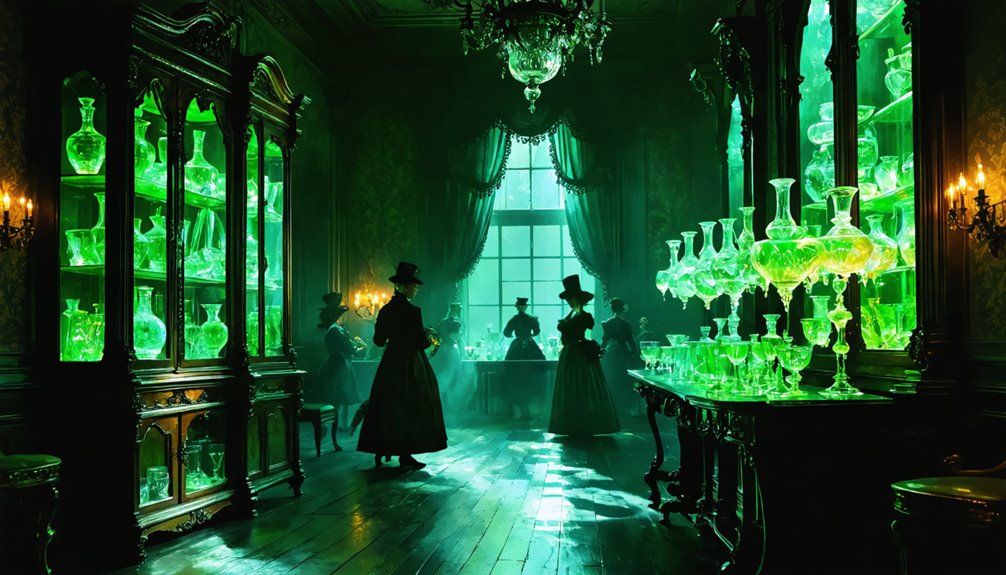
Usage in Victorian Homes and Society
Victorians had a unique love for uranium glass, also known as Vaseline glass. This colorful material was more than just a pretty decoration. It showed their excitement about science and new inventions. People liked to show off uranium glass in their homes, especially in parlors and dining rooms. The glass glowed under gaslight, making evening gatherings feel special.
Families often sought out different types of uranium glass. They wanted beautiful tableware for fancy dinners, striking figurines to catch the eye, decorative lamps to brighten rooms, and serving dishes for both everyday meals and celebrations. Owning these items was a sign of sophistication and a connection to the progress of the time.
The popularity of uranium glass during the Victorian era reflected a broader cultural trend. Many people were fascinated by science and technology. This glass became a symbol of modern living and a way for families to express their status in society.
They embraced new materials and designs, showcasing their taste and awareness of the latest advancements.
Safety and Health Perceptions in the Victorian Era
When I think about Victorian England, I notice how people welcomed uranium glass. Many didn’t know about the dangers of radiation because scientific understanding was still developing.
Interestingly, some Victorians thought that items made with uranium could improve health. This shows how much they trusted new scientific ideas, even if there was no solid medical proof.
A few health advocates warned about the potential risks of these radioactive items. However, most people didn’t seem worried. This lack of concern allowed uranium glass to become popular and thrive without much oversight or regulation.
These vibrant glass pieces, known for their striking green color, were often used for tableware and decorative items. The glow they emitted under ultraviolet light captivated many.
In a time when science was evolving, uranium glass represented both curiosity and a misunderstanding of safety.
Victorian Radiation Awareness
Uranium glass, often called Vaseline glass, became popular in the Victorian era. People loved its bright, glowing appearance. Back then, they didn’t understand the risks of radiation. The discovery of radioactivity only happened in 1896. Before that, uranium glass was a novelty, captivating many with its unique aesthetic.
Victorians were drawn to its beauty. The glow fascinated them. They saw it as a fun and decorative item, not knowing it could be harmful. There were no safety guidelines in place. This lack of information allowed uranium glass to be used freely in homes and public places.
Some people did worry about the effects of industrialization on health. However, these concerns were minimal. Most Victorians enjoyed the decorative qualities of uranium glass without questioning its safety. They trusted these beautiful items, unaware of the potential dangers associated with radiation exposure.
Perceived Health Benefits
Have you ever thought about why Victorians adored uranium glass, even though it posed hidden radiation risks? In the Victorian Era, this type of glass was more than just a pretty item. Many people believed it had health benefits. They thought the uranium inside the glass had cleansing properties that could boost their health.
The striking glow of uranium glass under gaslight was mesmerizing. It symbolized energy, modernity, and innovation. These qualities attracted health-conscious Victorians. They didn’t fully grasp the dangers of radiation. Instead, they believed that low-level exposure could actually be good for them.
Uranium glass was marketed for its beauty, but it also represented scientific advancement and improved hygiene practices. This aligned perfectly with society’s desire for better health.
People wanted to embrace new trends, and uranium glass became a part of that journey toward what they thought was a healthier life.
Concerns and Public Reaction
Uranium glass was a popular trend in Victorian society. Its captivating glow fascinated many. However, by the late 19th century, people began to voice concerns about its safety. Initially, the public was excited about the unique properties of uranium glass.
As time passed, questions arose regarding its possible radioactive nature. Scientific studies started to highlight the hidden dangers of radiation. Researchers found that exposure could lead to health risks over time.
Media outlets began to report on these findings, which made people more cautious about using uranium products. The connection between uranium and nuclear science also stirred fears among the public.
Consumer advocacy groups emerged, urging manufacturers to take these safety concerns seriously. They pushed for better transparency and for companies to ensure the safety of their products.
As a result, the charming allure of uranium glass was overshadowed by growing awareness and apprehension about its potential health impacts.
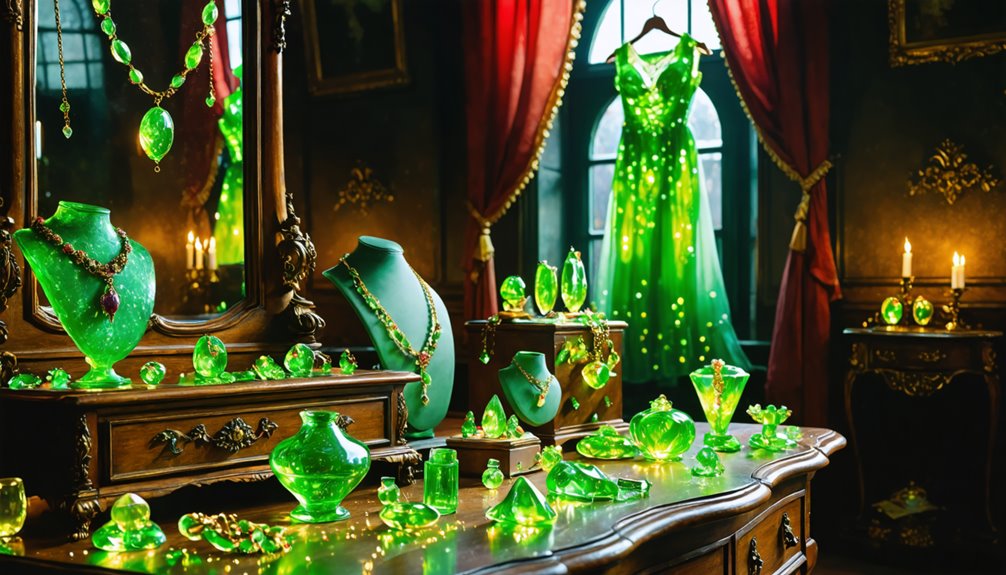
Decorative Patterns and Designs
Uranium glass, also known as Vaseline glass, first gained popularity in the 19th century. This type of glass contains small amounts of uranium, which gives it a unique glow under ultraviolet light. Early artisans used this fascinating material to create beautiful decorative pieces.
Victorian artisans showcased their talents through various decorative patterns. You can find detailed floral designs and sharp geometric shapes that highlight their craftsmanship. A well-known style from this period is the Hobnail pattern. It features tiny, raised bumps that create a textured surface. This texture not only adds depth but also reflects light in a striking way, making the glassware visually appealing.
Artisans employed specialized techniques to enhance these patterns. Methods like wheel-cutting and engraving allowed them to create intricate designs on the glass surface. They also added applied elements, such as handles or finials, to offer more dimension and interest. You can see these details in fine pieces like bowls and ornate vases.
Uranium Glass in Victorian Fashion and Jewelry
Uranium glass, popular in Victorian England, had unique uses in fashion and jewelry. Its distinctive fluorescent glow drew attention and made pieces stand out. Upper-class individuals wore jewelry made from this glass. It didn’t just showcase wealth; it also showed their interest in new science. The yellow-green color of uranium glass matched well with the light pastel colors that were trendy at the time.
Uranium glass jewelry in Victorian England showcased wealth, scientific curiosity, and fashionable elegance with its distinctive fluorescent glow and trendy pastel pairing.
Victorians cherished several types of uranium glass items. Here are some examples:
- Brooches: These had intricate designs and lit up evening gowns.
- Earrings: They added a subtle sparkle, enhancing elegance.
- Hair Combs: These were ornate and added beauty to various hairstyles.
- Unique Jewelry: Some pieces skillfully combined uranium glass with precious metals like gold or silver, showing great craftsmanship.
Each item reflected the creativity and love for unique materials during that era. The use of uranium glass in jewelry not only marked a fashion statement but also highlighted the influence of scientific discoveries on daily life.
Influence on Glass Manufacturing Innovations
Uranium glass, often seen as a quirky decorative item, actually changed glass manufacturing during the Victorian era. In the 1830s, Bohemian glassmakers like Josef Riedel began using uranium oxide. This innovation led to bright yellow-green colors like Annagruen and Annagelb. These shades were new in the world of glassware.
This colorful breakthrough raised artistic standards. It led to new techniques and methods in glass production. Consumers were excited, and demand soared. Companies such as Whitefriars Glass recognized this trend. They began to produce uranium glass widely, making it a popular choice among buyers.
The unique glowing properties of uranium glass became even more appealing with the rise of gaslight technology. This lighting made the glass sparkle and shine in ways that fascinated people.
Glassmakers were inspired to try new designs and refine their craft. They wanted to take advantage of this captivating glow. The early uses of uranium glass not only reflect creativity but also show how science and art can come together in unexpected ways.
Decline in Popularity After the Victorian Period
History of Uranium Glass
Uranium glass, also known as Vaseline glass, was once a popular item in homes during the Victorian era. People loved its unique greenish hue and the way it glowed under UV light. This glass was made by adding small amounts of uranium to the glass mixture, giving it properties that captured the imagination of many.
After the Victorian period, the charm of uranium glass started to fade. Several reasons contributed to this decline. First, there was growing worry about radiation. After World War II, people became more aware of the dangers associated with nuclear materials. This concern made uranium glass less appealing to the public.
Second, electric lighting took over homes. People no longer relied on gas or kerosene lamps. The special glow of uranium glass wasn’t as noticeable in bright electric light. This shift in lighting changed how people viewed and used decorative items.
Next, regulations changed. Governments became stricter about using materials that contained uranium. By the 1950s, many manufacturers had stopped producing uranium glass altogether. The combination of public unease and legal restrictions led to a significant drop in its production.
At the same time, design trends evolved. The mid-20th century saw the rise of new materials and styles that captured consumer interest. As a result, fewer people sought out uranium glass for their collections.
However, things began to change in the 1980s. Collectors rediscovered uranium glass. They appreciated its vibrant fluorescence under UV light and its fascinating history.
Today, uranium glass is celebrated for its unique characteristics and is sought after by collectors and enthusiasts alike.
Frequently Asked Questions
How Can You Tell if Uranium Glass Is Vintage?
To determine if uranium glass is vintage, you can use several methods. First, shine a UV light on the glass. Vintage uranium glass glows bright green under UV light due to its uranium content. This fluorescence is a key indicator of its age.
Next, take a close look at the color variations. Vintage pieces often have unique shades and patterns. They may range from pale green to deep olive or even clear with green accents. Each piece tells a story through its hue.
Markings can also help identify the glass’s origin. Many reputable manufacturers, like Fenton or Westmoreland, marked their products. By researching specific markings, you can trace a piece back to its production period.
Lastly, delve into the history of uranium glass production. It became popular in the late 19th century and surged in the 1930s and 1940s. Understanding these timelines can also help you estimate the age of your glass.
In short, these methods—UV light, color examination, markings, and historical research—can guide you in identifying vintage uranium glass accurately.
How Can You Tell if Glass Is Victorian?
To identify Victorian glass, focus on its unique features. Look for complex patterns and the ornate styles typical of the Victorian era. The colors can vary significantly, adding to the charm of these pieces.
Uranium glass, known for its distinct green or yellow hues, has a fascinating history. Early uses of this glass date back to the mid-19th century. It was popular for decorative items and tableware. People loved how it glowed under ultraviolet light, a result of the uranium content.
Feel the texture of the glass. Many Victorian pieces have intricate finishes that enhance their beauty. The glow of uranium glass is not just eye-catching; it also has historical significance. It showcases the innovative spirit of the time.
Is Vintage Uranium Glass Toxic?
Uranium glass has a unique history. It was first made in the late 19th century. Glassmakers added uranium to glass to give it a distinctive green or yellow color and to enhance its brightness. This glass became popular for decorative items and tableware.
The early uses of uranium glass were mainly in the production of art pieces and household items. It was not uncommon to find uranium glass in homes during the 1920s and 1930s. People loved its vibrant colors and unusual glow under ultraviolet light.
While uranium is a radioactive element, the amount used in glass is very small. Studies show that the radiation levels are low and generally considered safe for display. Researchers have found that using uranium glass for practical daily purposes is not ideal due to potential long-term exposure, but having it as a collectible is quite common.
Collectors today value vintage uranium glass for its beauty and historical significance. It’s a fascinating part of glassmaking history, showing how materials can be creatively utilized. Just remember, it’s best admired on a shelf rather than used every day.
Is Vintage Uranium Glass Valuable?
Uranium glass has a fascinating history. It began in the early 19th century when glassmakers discovered that adding uranium to glass could create a unique green or yellow hue. This glass, often called “Vaseline glass,” glows under UV light due to the uranium content.
In the late 19th and early 20th centuries, uranium glass became popular for its striking appearance. Many households used it for everyday items like dishware and decorative pieces. The glass was affordable and added a touch of color to homes.
During World War II, the production of uranium glass slowed down due to materials being redirected for military use. After the war, it saw a resurgence in popularity. Collectors began to appreciate the beauty and history behind these pieces.
Today, vintage uranium glass can attract collectors, especially those who seek rare and unique items. The value of these pieces depends on their rarity and demand among buyers. Unique shapes and colors often fetch higher prices.
Conclusion
Uranium glass, often called “Vaseline glass,” caught the attention of Victorian England. This unique glassware was not just about looks; it represented creativity and innovation in craftsmanship. People loved its gentle glow under UV light, which added a bit of magic to their homes.
Victorians were drawn to the glass’s quirky charm. It became a popular item at dinner parties and in displays. However, many preferred to overlook its radioactive nature. They saw it as an oddity rather than a danger. This fascination kept the market alive for a while.
As time passed, views on safety changed. Concerns about radiation became more prominent. The demand for uranium glass started to fade. Today, it serves as a reminder of a time when beauty and risk coexisted. It reflects the opulence and creativity of the Victorian era while also hinting at the hidden dangers of aesthetic choices.



